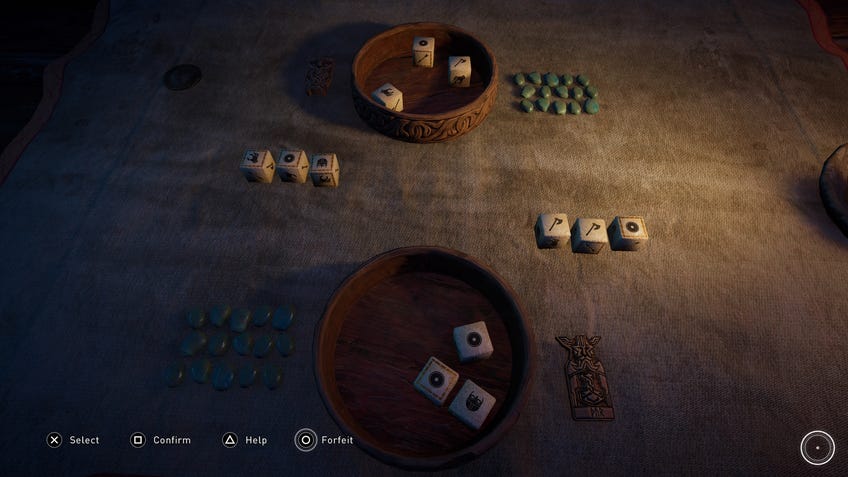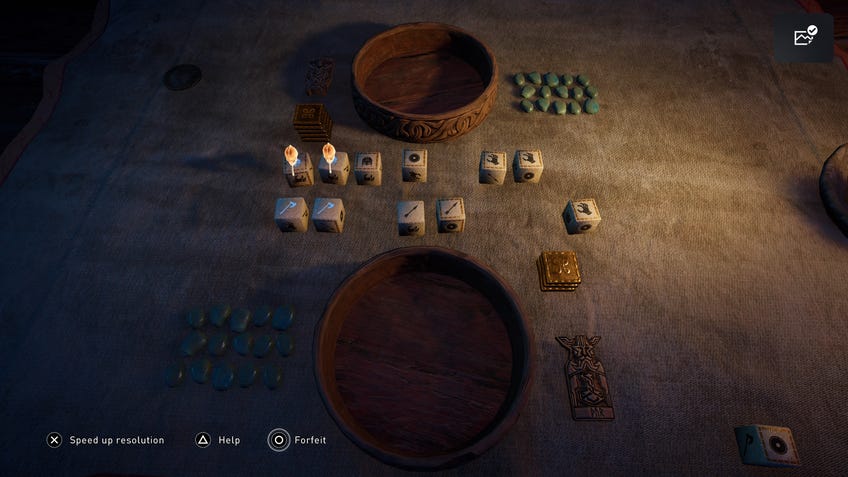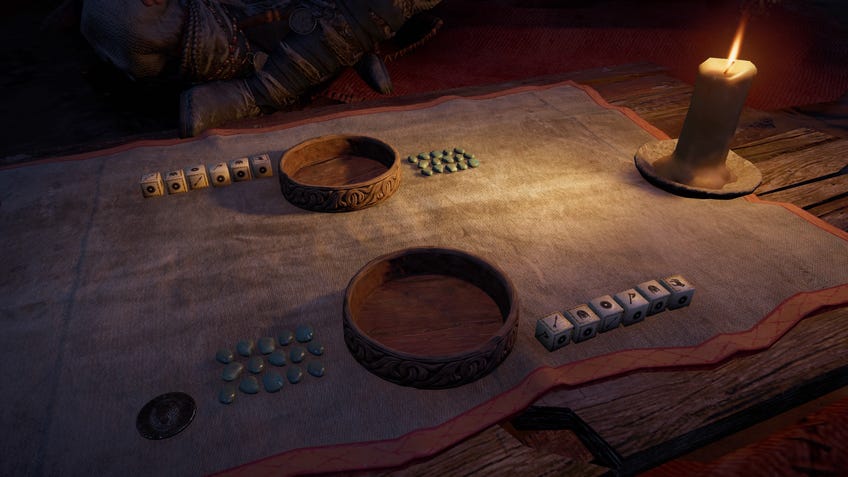Assassin's Creed: Valhalla's Viking dice game Orlog will get a physical version in 2021
Plus, a talk with co-dev game director Benoit Richer about bones, difficulty and Tabletop Simulator.
Ubisoft’s latest sprawling, open-world video game, Assassin’s Creed: Valhalla, puts players in the axe-toting, longboating boots of Norse raider Eivor. Hold on: before you go double-checking which website you visited, there is a perfectly cromulent, board gamey reason to talk about Valhalla. Littered around both Norway and England are tables decorated with an unassuming collection of carved tokens and dice. This is Orlog, a favoured pastime of Eivor’s people that many players have come to love, as well.
Dicebreaker has learned that Ubisoft will be working with pop culture collectibles producer PureArts to publish a physical version of Orlog in 2021. Ubisoft did not provide any further details or dates at this time.

Orlog takes a more understated approach to conflict compared to the hours of pillaging and brawling that composes Valhalla’s main campaign. Eivor can find willing opponents next to hearths, along cliffside overlooks or other calm spots with enough space to spread out a leather skin and two wooden bowls. The point of the game is to reduce your opponent’s life pool - represented by rows of smooth stones - to zero before they can deal you the same fate.
Players take turns tossing a collection of six dice decorated with an axe, arrow, shield, helm or gauntleted hand. These correspond to the main actions you take against your opponent, respectively: melee attacks, ranged attacks, ranged block, melee block or steal resource. On each of three throws, you may choose to hold back the results of your roll and retoss the rest. Players alternate, giving each a chance to react or change their strategy.
The biggest wrinkle to this relatively straightforward dice game comes in the form of god favours. The energy resource you collect from certain die faces can be spent to activate a special ability granted to players by one of three carved idols on the board. These correspond with notable deities like Thor, Lokis or Baldr, and each brings different effects to bear. Choosing which favours to equip for each match can drastically change your strategy.
According to Ubisoft co-development game director Benoit Richer, the shipped version of Orlog wasn’t always what Ubisoft had in mind. Initially, it played more like a deckbuilding game where players collected unique dice from the world to customise their throws. “We always wanted to have the aspect of the gods’ powers influencing it somehow, so on that version it was a face on the die that was representing a god type,” Richer told Dicebreaker. “The goal for that was to be able to roll multiple faces of that god to take effect.”
This version grew too cumbersome to balance as a side activity, so playtesting teams in Singapore and Chengdu simplified the core dice-matching mechanic for accessibility. The god dice became the collectible favour carving, also preserving that initial customisation thread.
Richer admitted that while the development team are professed “board game enthusiasts”, none boast professional design experience. This made creating a version of Orlog that was satisfying to play while also fitting into the expectations of a side activity a challenge. Much like board games, they went through a “paper design phase” with the teams in Singapore and Chengdu, who have worked on virtual card games including Uno and Might & Magic in the past.
The mess of sticky notes, scratch paper and physical dice gradually took shape through playtesting, but as development stretched into 2020 the three teams needed a digital solution. A group of designers mocked up Orlog in digital board game sandbox Tabletop Simulator, allowing everyone to experience the evolving versions in a faux-analogue fashion.

Those unfamiliar with traditional Scandanavian pastimes might wonder whether Orlog was based on a real game Vikings played during the hours not spent burning churches and going on hallucinatory quests. Unfortunately, anthropologists won’t find these specific bags of dice buried with raiders. “The goal was to have a game that would be ‘credible’ rather than historically accurate as we didn’t find any clear rules throughout our research,” Richer said.
That’s not to say these people didn’t play anything - hnefatafl games were a large category of physical strategy games enjoyed by fighters and farmers alike. They often used carved figures on a wooden or cured leather board, but sometimes variants would employ hand-carved dice. Richer said these cylindrical or uneven shapes just didn’t work very well with the physics engine used in Assassin’s Creed: Valhalla, which is why Eivor’s kith and kin all have access to standardised cubes.
Ubisoft did strive for authenticity in the materials Norse raiders would have on hand, such as bone, wood, stone and sometimes silver. Throw in a little weathering from crossing the salty ocean dozens of times in a pouch, and you have something that looks period-appropriate.
Richer added that Eivor is a canonical lover of board and dice games: “Norse culture was about gaining pride and avoiding shame in every aspect of their lives, such as combat, politics, arguments and sports.” We can’t help but imagine Eivor absolutely crushing it as the vagabond raccoons in Root.
Edit: A previous version of this story referred to Benoit Richer as game director for Assassin's Creed: Valhalla. Richer is co-development game director. This has been updated.


